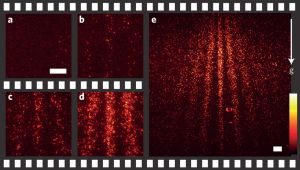Quantum theory describes the world of atoms very precisely. Still, it defies our macroscopic conception of everyday’s world due to its many anti-intuitive predictions. The wave-particle dualism probably is the best known example and means that matter may spread and interfere like waves. Now, an international team of researchers has recorded the interference process of individual molecules. The recordings were published by the journal “nature nanotechnology” online.
“Seeing how the interference pattern develops with every light spot, molecule after molecule, and how a basic principle of quantum mechanics is visualized enhances our understanding of the atomic world,” explains Professor Marcel Mayor, who conducts research and teaches at Karlsruhe Institute of Technology and the University of Basel.
For the experiment performed in cooperation with colleagues from the universities of Vienna and Tel Aviv, Mayor synthesized fluorescent phtalocyanin molecules having an atomic mass of up to 1298 AMU and consisting of up to 114 atoms. Then, the molecules were accelerated, sent as a slow beam through an optical grating, and deposited on the entrance vacuum window, where they were excited to fluoresce by a laser. For a period of 90 minutes, a fluorescence microscope observed the build-up of the interference pattern. Its setup has a sufficient sensitivity to exactly locate every individual molecule on the window with a precision of about 10 nanometers.
In the future, the setup might be used to study the so-called van-der-Waals interaction between molecules in the beam and those in the grating, which is reflected rather sensitively by the interference pattern. Researchers are also interested in finding out from which size and under which conditions particles behave quantum mechanically or classically, i.e. in the so-called decoherence. These findings may be the basis for novel applications, such as quantum computers. “But the many insights given by this experiment into the quantum world and its boundaries already are of high value,” Mayor agrees with many experts, among others Bum Suk Zhao and Wieland Schöllkopf from the Fritz Haber Institute, Berlin, who evaluate the experiment in the accompanying comment article in the same journal.
“Real-time single-molecule imaging of quantum interference”, T. Juffmann et al., nature nanotechnology, DOI 10.1038/ NNANO.2012.34
The paper in the web portal of the nature nanotechnology journal
http://www.nature.com/nnano/journal/vaop/ncurrent/full/nnano.2012.34.html
Accompanying comment article
http://www.nature.com/nnano/journal/vaop/ncurrent/full/nnano.2012.44.html
Being “The University in the Helmholtz Association”, KIT creates and imparts knowledge for the society and the environment. It is the objective to make significant contributions to the global challenges in the fields of energy, mobility, and information. For this, about 10,000 employees cooperate in a broad range of disciplines in natural sciences, engineering sciences, economics, and the humanities and social sciences. KIT prepares its 22,800 students for responsible tasks in society, industry, and science by offering research-based study programs. Innovation efforts at KIT build a bridge between important scientific findings and their application for the benefit of society, economic prosperity, and the preservation of our natural basis of life. KIT is one of the German universities of excellence.

